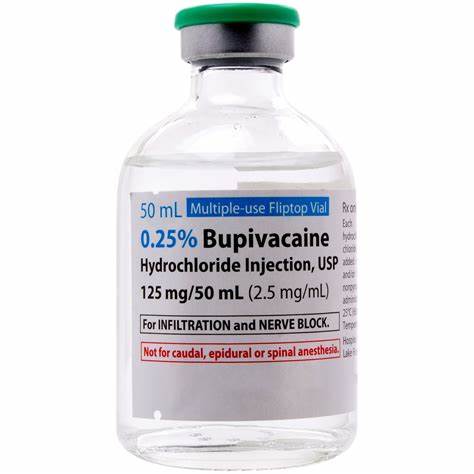Bupivacaine, which is marketed under the brand names Marcaine and others, is a medication that is used to numb a specific area of the body. It is injected around a nerve that supplies the area or into the epidural space of the spinal canal in nerve blocks.
Bupivacaine uses
Bupivacaine injections are used to numb an area of the body before, during, or after surgery, childbirth, or dental work. Additionally, this medication is used to numb the shoulder for up to 72 hours following surgery. It is used as a topical anesthetic.
How does it work?
Local anesthetics such as bupivacaine inhibit the generation and conduction of nerve impulses, presumably by raising the threshold for electrical excitation in the nerve, slowing the nerve impulse’s propagation, and lowering the action potential’s rate of rise. Bupivacaine blocks sodium ion influx into neurons by binding to the intracellular portion of sodium channels. Anesthesia progresses in general in direct proportion to the diameter, myelination, and conduction velocity of the affected nerve fibers. Clinically, nerve function is lost in the following order: pain, temperature, touch, proprioception, and skeletal muscle tone. Bupivicaine’s analgesic effect is thought to be due to its binding to prostaglandin E2 receptors, subtype EP1 (PGE2EP1), which inhibits prostaglandin production, thereby decreasing fever, inflammation, and hyperalgesia.
Bupivacaine Dosage
Infiltration on the Local Level:
0.25 percent concentration: Inject up to 175 mg
Epidural Stimulation:
Concentration of 0.75 percent 75–150 mg (10–20 mL) intravenously once for complete motor block; not for obstetric anesthesia.
50–100 mg (10–20 mL) for moderate to complete motor block; repeated doses increase the degree of motor block.
inject 25 to 50 mg (10 to 20 mL) for partial to moderate motor block; repeated doses increase the degree of motor block.
Epidural Anesthesia: 0.5 percent and 0.75 percent solutions should be administered in 3–5 mL increments with enough time between doses to detect toxicity or accidental intravascular or intrathecal injection.
Epidural Anesthesia in Obstetrics: Only 0.5 percent and 0.25 percent solutions should be used; the 0.5 percent solution should be administered in 3 to 5 mL increments not exceeding 50 to 100 mg at any dosing interval; repeat doses should be administered following a test dose containing epinephrine unless contraindicated; and only preservative-free products should be used.
Caudal Obstruction:
75–150 mg (15–30 mL) for moderate to complete motor block; repeated doses increase the degree of motor block.
Inject 37.5 to 75 mg (15 to 30 mL) at a 0.25 percent concentration for moderate motor block; repeat doses increase the degree of motor block.
Administration
Bupivacaine is injected directly into or near the area to be numbed with a needle. This injection will be administered in a dental or hospital setting. Bupivacaine is injected into an area of your middle or lower back near your spine for an epidural.
Bupivacaine side effects
Marcaine’s most frequently encountered adverse effects are associated with greater doses and inadvertent injection into alternate areas. Absorption of the drug into the bloodstream may result in adverse consequences like as:
- Hypotension
- Slow heart rate
- Arrhythmia or tachycardia
- Cardiopulmonary arrest
Marcaine may also cause the following adverse effects:
- Indigestion
- Vomiting
- Urinary and fecal incontinence
- Sexual function loss
- Blurred vision
- Ears ringing, and
- Articular cartilage loss
Drug interaction
Bupivacaine is not known to have any serious interactions with other medications. There are no known severe interactions between bupivacaine and other medications.
Bupivacaine has a number of mild interactions with:
- Benazepril
- Liposome bupivacaine
- Captopril
- Dofetilide
- Nadolol
- Nevirapine
- Pindolol
- Proprandolol
- Timolol
- Hyaluronidase
Precautions/ safety information
Additionally, bupivacaine injections may result in a hazardous rise in body temperature (hyperthermia). Consult your physician if you or your child have rapid shallow breathing, a fast, weak heartbeat, headache, muscular cramps, pale, clammy skin, or an unusually high fever or body temperature.
Storage
Store between 20°C and 25°C (68°F and 77°F); excursions between 15°C and 30°C (59°F and 86°F) are acceptable.
Contraindications
This medication is contraindicated in the following conditions. Consult your physician if you suffer from any of the following conditions:
Conditions:
- Deficiency of glucose-6-phosphate dehydrogenase (G6PD)
- Atrioventricular heart block of the second degree
- Heartbeat that is sluggish
- Blood pressure is abnormally low
- Liver illness that is serious
- Shock is a condition in which the body is unable to sustain enough blood flow.
- Pyruvate kinase and G6PD deficiency anemia
- A condition in which the heart slows abnormally but slightly, referred to as first degree atrioventricular block
- Renal disease associated with a predicted decrease in kidney function
Pregnancy or lactation
Pregnant women should use bupivacaine with caution unless the benefits outweigh the hazards. Animal studies demonstrate risk, while human studies are either unavailable or have not been conducted.




